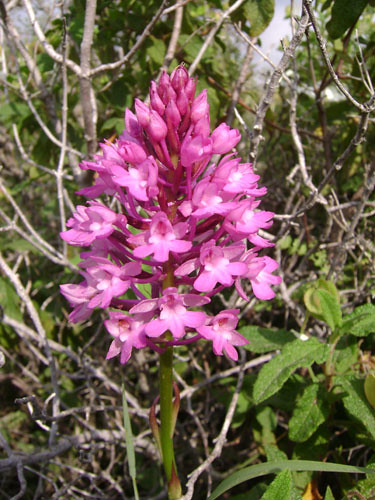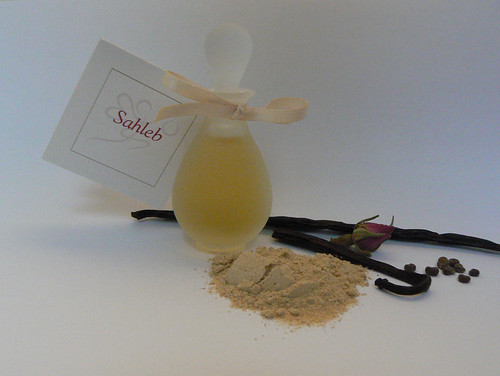Orchid, Pudding, Perfume: The Sahleb Story

Sahleb Orchid, originally uploaded by Ayala Moriel.
Sahleb perfume was born from three simple elements: Beurre d’Iris, butter essence the obscure and comforting pudding-beverage. It was meant to be a simple comfort scent, with no particular baggage or deep history. The name of the beverage suggests its origin: Sahleb is in Arabic word for orchid (Sachlav in Hebrew). And indeed, Sahleb is made of the ground starchy bulb of a Mediterranean species of orchids: Early Red Orchid (Orchis mascula).
Several orris butters have passed by my nose in my last 8 years of perfumery. But no orris root really fascinated and excited me as much as a particular batch I received from Eden Botanical: Beurre d’Iris (aka orris butter -which really is the essential oil, but with a consistency of crumbly butter or powdery wax). It come stright from Florence, Italy, where the Iris pallida grows, and is the most creamy, smooth and sweet orris I’ve ever encountered. Warm rather than the cool and vague, distant powderiness that most orris butter present.
Orris butter is one of the most precious perfumery materials, currently set at nearly $7,000 per pound. There is much labour involved in the process: the roots need to be washed and peeled by hand and than mature for several years in dark cellars. They are than pulverized before being distilled into an essential oil. Lastly, the yield is relatively low which makes it prohibitive; yet at the same time, the presence of irone, a violet-like molecule similar in its aroma to ionone, makes it invaluable in perfumery. The particular orris butter in question had 15% irone, which is almost the highest irone content one can hope for (sometimes, 20% irone is available).
The butter CO2 is a molecular distillation of this beloved dairy product. If you ever fry your eggs with a bit of butter, or make homebaked crumbly butter cookies or pie crusts - this is the scent of butter CO2. When I first smelled it I was simultaneously repulsed and intrigued by how realistic and potent it was. It simply hits your nose with this burnt-butter sensation, suffocating and comforting at once. Just like a late, fat Sunday brunch.

Sahleb Merchant, originally uploaded by Ayala Moriel.
My constant inspiration comes from home, where I grew up in the Middle East, surrounded by an abundance of flavours and fragrances native to my country. Living in Vancouver most of the year, I miss all of the plants and smells and little edible pleasures of daily life. Especially on days when I go to my neighborhood Middle Eastern deli and there is no sahleb on the shelf (or worse: no tahini! But that’s because my brother probably ate all of the tahini supply in the city in his 12 months stay in Vancouver). On days like this a perfume can help bridge over the physical distance and give the illusion of closeness, and the comfortable certainty of nostalgia.
For those of you who haven’t been fortunate enough to try sahleb (yet), you must know that it is the most comforting beverage you can imagine, and at the same time exotic and intriguing. It is made of ground starchy orchid root powder, cooked with milk and a bit of sugar and rosewater (sometimes ground mastic resin is added too). It is served warm and topped with crushed pistachios, coconut and spice (most typically cardamom and cinnamon). In Café Clil in my home village, it is served with a split banana and some peanuts on the side as well, which is original, different yet appropriate.
Somehow, it all came together in my mind and I was determined to make a perfume inspired by Sahleb. Sahleb required subtleness and richness and had to be very milky and starchy. So it was only natural that I would use the obviously milky butter essence, and the haunting orris butter with 15% irone. And that how Sahleb was born. Ambrette seed was crucial for the composition’s fatty quality and also to make it more perfumey and skin-like. There is only very little rose in the perfume, as well as a bit of mastic resin tincture which I had to prepare myself. The spices and top notes used also have some starchy quality to them – coriander and rosewood.
Unfortunately, when I was ready to launch Sahleb this season, I learned that my supplier have run out of the orris and were not able to anticipate when this quality iris will be back in stock. I have a feeling that the wave of iris scents that washed us throughout last year (i.e.: Iris Ganache, Infusion d’Iris…) have used up a large portion of the world’s supplies and I am now in a bit of a panic regarding finding quality orris butter for my perfumes.
Therefore, I have decided to launch Sahleb as an exclusive limited edition, which means with a price point ($160) that truly reflects it’s cost, and in very limited run of only 11 bottles (2 of which were already taken). Also, there are no samples offered for Sahleb perfume - aside from samples that I have given out before I knew of this little “orris crisis”, and 5 more that are in stock there will be no samples available.










